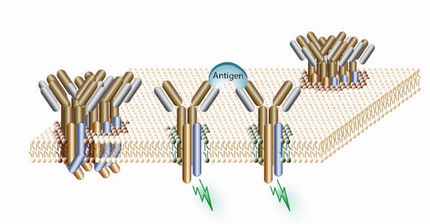The handicraft of cellular transport complexes
A protein complex, which is an important link in a cellular transport chain, also initiates the assembly of the next link in the chain. This newly-won insight will now allow a better understanding of a transport process that plays a crucial role in numerous cellular processes including virus infections, cell division and signal transmission. The additional function of the ESCRT-II transport complex was discovered during the course of a research project funded by the Austrian Science Fund FWF and reported in The EMBO Journal .
Virus infections, cell division and signal transmission have something in common: they make use of a "protein machine" that actually controls a cell disposal process. The assembly of this molecular "machine" is highly controlled and is mainly influenced by five particular protein complexes. The protein complexes in question are referred to as ESCRTs (endosomal-sorting complex required for transport). A team from Innsbruck Medical University and Cornell University in the USA has now discovered a surprising function of one of the ESCRT complexes (No II): ESCRT-II also initiates the assembly of ESCRT-III, the central complex in the transport chain.
All ESCRTs share the function of loading the cellular transport vesicles (MVB - multi vesicular bodies) with cell surface components that have become "unwanted". For this purpose, the ESCRTs are generated only temporarily. Dr. David Teis from the Division of Cell Biology at Innsbruck Medical Hospital explains the new function of one of the ESCRTs discovered by his team as follows: "A part of ESCRT-II, known as Vps25, triggers a kind of chain reaction, which initially gives rise to a structural change in another protein called Vps20. Vps20 is more or less activated by the structural change and other proteins - SnF7s - can then group around Vps20. Subsequently, the rest of the ESCRT-III forms around this starting point. In this way, ESCRT-II initiates the assembly of ESCRT-III."
To be more precise, approximately 10 - 20 Snf7 proteins must assemble in a defined ring-like form so that the other ESCRT-III components can be added as required. It is precisely this ring-like grouping of the Snf7 proteins that is influenced by the Vps25. The team working with Dr. Teis was able to discover this through experiments involving the clever modification of ESCRT-IIs: instead of the usual two Vps25s, only one was used for ESCRT-II. Dr. Teis explains: "This enabled us to show that, despite the reduced number of Vps25s in the ESCRT-II, the Snf7s still grouped together. However, the molecules that assembled in this way were not able to fulfill the biological function of ESCRT-III."
Based on the known fact that the two Vps25 proteins of the ESCRT-II form a Y-shaped structure, Dr. Teis made the following deduction from this finding: the two arms of the Y formed by the Vps25 together enable the suitable ring-shaped arrangement of the Snf7 molecules. While one "arm" is sufficient to group the Snf7s, two Snf7s must be deposited - one on each arm - for the spatial structure to accommodate the further assembly of the ESCRT-III.
This ring structure then acts as a kind of master copy for the MBV transport vesicles. This assumption was confirmed in a further experiment which Dr. Teis carried out with his co-operation partner Professor Scott Emr from Cornell University in the USA. For this experiment, more Snf7 molecules than usual were formed in cells with an altered molecular composition. The result? The vesicles that formed in these cells were significantly larger - providing a clear indication of the role of the Snf7 protein as a master copy.
In summary, these results, stemming from an FWF project, not only reveal the extent to which this cellular disposal mechanism is finely tuned, but also demonstrate its hitherto unknown capacity for molecular self-assembly.
Original publication: D. Teis, S. Saksena, B. Judson and S. D. Emr; " ESCRT-II coordinates the assembly of ESCRT-III filaments for cargo sorting and multivesicular body vesicle formation"; The EMBO Journal (2010) 29, 871 - 883.
Organizations
Other news from the department science

Get the life science industry in your inbox
By submitting this form you agree that LUMITOS AG will send you the newsletter(s) selected above by email. Your data will not be passed on to third parties. Your data will be stored and processed in accordance with our data protection regulations. LUMITOS may contact you by email for the purpose of advertising or market and opinion surveys. You can revoke your consent at any time without giving reasons to LUMITOS AG, Ernst-Augustin-Str. 2, 12489 Berlin, Germany or by e-mail at revoke@lumitos.com with effect for the future. In addition, each email contains a link to unsubscribe from the corresponding newsletter.
Most read news
More news from our other portals
Last viewed contents
TORCH_infections

Skyray Instrument Inc. - Yushan Zhen, China
Progress in pursuit of sickle cell cure

New analgesic could replace opioids over the long term - Researchers find a natural active substance that could replace opioids in the long term and alleviate the opioid crisis
Texas A&M team finds neuron responsible for alcoholism




















































